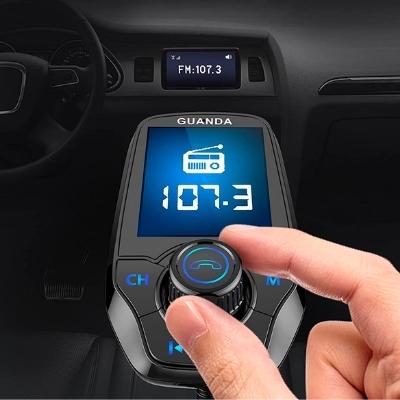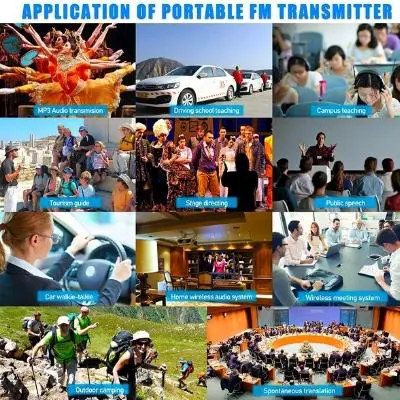How To Set Up an FM Transmitter In a Car
An FM transmitter, a compact and portable device, can revolutionize the way you listen to music in your car. Primarily, it converts an audio output into an FM radio signal. This signal can then be picked up by FM radio receivers within its proximity, effectively transforming your car into a temporary radio station.
In the digital age, most people have a comprehensive library of music on their smartphones or MP3 players. Easy access to this library on the go is virtually a necessity. This is where the FM transmitter comes in, allowing you to play your favorite tunes through the powerful speakers of your car stereo system, instead of the comparatively inferior smartphone speakers.
FM transmitters are typically of two types: standard and Bluetooth. Standard FM transmitters need to be connected using a cable, while Bluetooth FM transmitters allow you to connect wirelessly, thus avoiding any cumbersome wires.
Regardless of the type, setting up an FM transmitter in your car will enhance your music listening experience significantly.
If you’re looking for advice on The Best FM Transmitter for a Car, look no further as we have you covered….

Materials Needed
Setting up an FM transmitter in your car requires some basic stuff, so make sure you have the following before you start:
The FM Transmitter: The primary component, it can be a standard transmitter that requires a cable connection or a Bluetooth one for a wireless connection.
Car’s Audio System: The car’s stereo system is where you’ll tune into the FM frequency that you set on the transmitter. Most modern cars come with FM radio functionality.
Compatible Device to Connect: The device, such as a smartphone or MP3 player, will serve as the source of the audio that you want to broadcast through the FM transmitter.
Cables or Bluetooth: For a standard FM transmitter, you will need the appropriate cable to connect the transmitter to your audio device. The cable usually comes along with the FM transmitter. For a Bluetooth FM transmitter, you’ll only need to ensure that both the transmitter and your audio device have Bluetooth functionality turned on.
Choosing the Right FM Transmitter
Choosing the right FM transmitter is critical to ensuring optimal performance and compatibility with your devices. Here are some important criteria to consider when making your selection:
Device Compatibility: Not all FM transmitters are compatible with all receivers. While most modern transmitters are designed to work with Android and iPhone mobile phones, compatibility issues may arise with less common MP3 players.

Advice for Choosing the Best FM Transmitter for a Car: When selecting an FM transmitter, prioritize quality. While range varies among transmitters, most good quality devices have an average range of about 10 meters. Also consider the location and situation where you’ll be using the transmitter. For instance, in urban areas where many frequencies are in use, a transmitter with a low output may experience interference.
The choice between a standard and a Bluetooth transmitter will depend on your specific needs. If you prefer a wire-free setup and your device supports Bluetooth, then a Bluetooth FM transmitter would be the right choice.
However, if your device doesn’t support Bluetooth or you don’t mind using cables, a standard FM transmitter will serve you just fine. Remember to read user reviews and ratings to make an informed choice.
How To Set Up an FM Transmitter In a Car
Setting up an FM transmitter in a car involves some simple yet crucial steps. The process slightly varies depending on the type of FM transmitter you’re using – a standard one or a Bluetooth version.
Steps to Set Up a Standard FM Transmitter in a Car:
- Plug the FM transmitter into your car’s 12V power port or cigarette lighter.
- Connect the cable that came with your device from the FM transmitter’s USB output to your smartphone or MP3 player.
- Choose a radio frequency on your FM transmitter that isn’t being used on the radio. This would depend on your location as some frequencies may already be occupied. For instance, let’s say you select 107.3 FM.
- Play music on your device via your preferred app (like iTunes or Spotify).
- On your car stereo, switch on your radio and tune it to the same FM frequency you set on your transmitter (in this case, 107.3 FM). Your selected music should start playing through your car’s audio system.
- Finally, adjust the volume. Lower it on your device and increase it on your car stereo for the best audio experience.
Steps to Set Up a Bluetooth FM Transmitter in a Car:
- Plug the Bluetooth FM transmitter into your car’s 12V power port or cigarette lighter.
- Enable Bluetooth on both your smartphone (or other devices) and the FM transmitter.
- Pair your device with the FM transmitter from the list of available Bluetooth devices on your smartphone.
- Once paired, follow the same process as for a standard FM transmitter: choose an unused radio frequency, start playing music on your device, and tune your car stereo to the chosen frequency.
Note: Once your devices have been paired via Bluetooth, in future uses they should automatically connect as long as Bluetooth is enabled on both devices.
FM Transmitters Other Use Cases
While the primary function of an FM transmitter is to enhance your music listening experience in the car, it can serve a variety of other purposes:

Creating an FM Radio Station for Camping Trips: If you’re on a camping trip or at a music festival with a group of friends, you can use your FM transmitter to create a shared music experience. Everyone can tune into the same FM frequency to enjoy the same playlist from their individual tents or RVs.
Hands-Free Calling: Many FM transmitters also support hands-free calling. This feature allows you to answer or dismiss calls with a simple button press, keeping you safe while driving. The calls will be broadcasted through your FM station and car speakers, providing clear audio for both you and the person on the other end of the call.
Charging Other Devices: Most FM transmitters come with a dual USB port, which can be used to charge other electronic devices. For instance, while playing music from your smartphone, you could also charge it or any other device with a USB connection, like a tablet or portable gaming device.
These additional uses make the FM transmitter a versatile and valuable device, capable of more than just transmitting your favorite tunes to your car stereo.
Issues with FM Transmitters
Like any device, FM transmitters can sometimes face minor issues. Here are some common problems and solutions:
Interference in Urban Areas: Due to the lower output of FM transmitters and the abundance of frequencies in use, interference can sometimes occur in urban areas. If you’re experiencing this, try changing to a different, unused frequency on the FM band to mitigate the interference.
Device Compatibility Issues: If your FM transmitter is not working with a certain MP3 player or smartphone, check the compatibility list provided by the manufacturer or vendor. If your device is not listed, you may need to find a different FM transmitter that supports it.
Bluetooth Connectivity Problems: If you’re having trouble connecting your Bluetooth FM transmitter with your device, try unpairing and then re-pairing the devices. Ensure that Bluetooth is enabled on both devices, and that they are within range of each other.
Audio Quality Issues: While FM transmitters don’t offer the same audio quality as a direct auxiliary connection, the sound should still be enjoyable. If the audio quality is particularly poor, check to make sure all connections are secure and try a different, clear frequency.
Remember that FM transmitters are not meant to be the primary source of car audio but rather a convenient solution for playing your music, making hands-free calls, and even charging devices on the go.
FM Transmitter – A Great Way to Share Your Tunes
So there you have it: how to set up an FM Transmitter. In the world of car audio, FM transmitters serve as a versatile and convenient tool, allowing you to enjoy your favorite music, engage in hands-free calls, and charge your devices on the go.
Despite potential minor issues, the benefits of using an FM transmitter significantly outweigh the challenges. Whether using a standard device or a Bluetooth variant, the setup process is straightforward and user-friendly.
Incorporating this device into your car’s audio system will undoubtedly enhance your driving experience with a rich selection of music and safer communication capabilities.

I am a passionate and skilled car audio enthusiast with 15 years of experience in the industry. My journey started when I replaced my first set of factory car speakers, sparking a deep love for high-quality sound. Since then, I have worked as a representative for renowned brands like Kenwood and Alpine.
With a background in both retail and distribution, I have developed a comprehensive understanding of the car audio market. Currently a certified (MECP) installer in the Mobile Electronics industry, my expertise lies in delivering top-notch audio installations. My knowledge, coupled with my genuine passion, makes me the go-to professional for all car audio needs.
